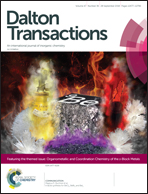Insight into the nature of M–C bonding in the lanthanide/actinide-biscarbene complexes: a theoretical perspective†
Abstract
We have investigated M–C bonds in lanthanide and actinide complexes ML2 (M = Ce, Th, U, Np and Pu; L = C(PPh2NMes)2) using scalar-relativistic theory. The M–C bonds possess typical σ and π bonding character, except for the nearly π-only Th–C bonds. The metal valence electrons significantly reside in the valence d and f orbitals for CeL2, UL2, NpL2 and PuL2, while for ThL2 most electron population is in 6d orbitals. The contribution of 6d orbitals to the An–C bonds decreases and that of 5f orbitals increases across the actinide series. QTAIM (quantum theory of atoms in molecules) and NBO (natural bond orbital) analyses confirm that the M–C bonds possess significant covalent character. This work provides insights into the contributions of d and f valence orbitals to M–C bonding. And inclusion of Np and Pu in this evaluation extends understanding to later actinides.



 Please wait while we load your content...
Please wait while we load your content...